Award of Excellence
School of Horology
Szue Hann Tan
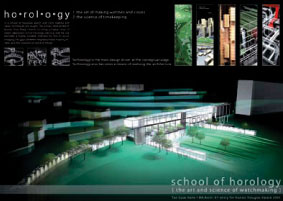 Tan, who holds First Class Honours in Architecture at NUS and is currently pursuing a Masters of Architecture in a joint NUS and University of California Los Angeles (UCLA) programme, wants to create better environments in which to live, work, and play. In doing so, he assesses these environments’ cultural backdrops and incorporates new architectural technologies that complement them. Tan, who holds First Class Honours in Architecture at NUS and is currently pursuing a Masters of Architecture in a joint NUS and University of California Los Angeles (UCLA) programme, wants to create better environments in which to live, work, and play. In doing so, he assesses these environments’ cultural backdrops and incorporates new architectural technologies that complement them.
The School of Horology, a breakthrough design for a specialised field that involves great precision and watch making, represents one such project. In conceptualising the project, Tan disassembled a watch and analysed its constituent parts. He then analogised each part's function with a functional school space. He equated the watch face and hands with the school's gallery space because both display information. He compared the core of the watch, the energy-storing mechanism, to the library -- the "storage" space. He incorporated these into an elegant structural form that integrates concept and reality.
In School of Horology, the designer explores a theme both traditional and contemporary -- the perception of time in a spatial context. In its engagement with site and culture, the project offers a chance to rethink the role of technology and the importance of inventiveness in an Asian intellectual context.
The judges deemed the project sophisticated and innovative in that the design incorporates technology both as a conceptual driver for the building and as a means of realising the intricacies of complex design. Since horology constitutes a field deep-rooted in both tradition and inventiveness, the school's architecture manifests that inventiveness.
In 2005 the project also garnered the Hunter Douglas Award for Innovative Use of Technology in Architecture and a nomination for the Royal Institute of British Architects’ (RIBA) President's Medal.
|


 he Society of American Registered Architects New York (SARA NY) Design Awards represents the highest level of architectural-design innovation and sophistication. In 2006, three National University of Singapore (NUS) architecture students scored an impressive record by clinching five of the top 13 awards in the student category.
he Society of American Registered Architects New York (SARA NY) Design Awards represents the highest level of architectural-design innovation and sophistication. In 2006, three National University of Singapore (NUS) architecture students scored an impressive record by clinching five of the top 13 awards in the student category.
 Tan, who holds First Class Honours in Architecture at NUS and is currently pursuing a Masters of Architecture in a joint NUS and University of California Los Angeles (UCLA) programme, wants to create better environments in which to live, work, and play. In doing so, he assesses these environments’ cultural backdrops and incorporates new architectural technologies that complement them.
Tan, who holds First Class Honours in Architecture at NUS and is currently pursuing a Masters of Architecture in a joint NUS and University of California Los Angeles (UCLA) programme, wants to create better environments in which to live, work, and play. In doing so, he assesses these environments’ cultural backdrops and incorporates new architectural technologies that complement them.
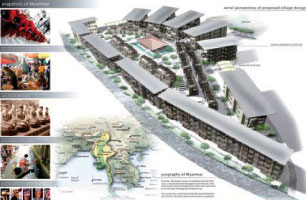 This project arose from a trip to Myanmar. The squalid living conditions Tan saw in Yangon, the nation's capital city, led him to investigate areas of the city where unlawful residents lived. He then proposed a model village for the squatters that would maintain Burmese socio-cultural elements integral to native perception of communal living -- and life.
This project arose from a trip to Myanmar. The squalid living conditions Tan saw in Yangon, the nation's capital city, led him to investigate areas of the city where unlawful residents lived. He then proposed a model village for the squatters that would maintain Burmese socio-cultural elements integral to native perception of communal living -- and life.
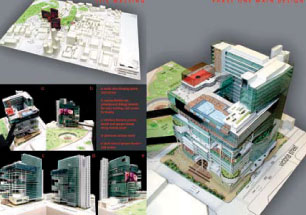 Lui, a practising architect who recently earned a Masters of Architecture from NUS, has earned accolades in the fields of architecture and industrial design; however, his thesis project adroitly combines the complexities of architecture and landscaping on a university campus. His project won him an Award of Excellence at the SARA NY 2006 Awards.
Lui, a practising architect who recently earned a Masters of Architecture from NUS, has earned accolades in the fields of architecture and industrial design; however, his thesis project adroitly combines the complexities of architecture and landscaping on a university campus. His project won him an Award of Excellence at the SARA NY 2006 Awards.
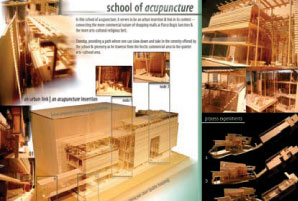 Kee recently graduated with Honours in Architecture at NUS. Her designs constantly challenge the perception of architecture in any given social context, yet still remain respectful of that context. These skills earned her two SARA NY Special Recognition Awards
Kee recently graduated with Honours in Architecture at NUS. Her designs constantly challenge the perception of architecture in any given social context, yet still remain respectful of that context. These skills earned her two SARA NY Special Recognition Awards
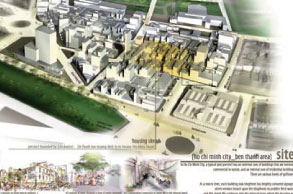 Kee's project began with a trip to Ho Chi Minh City, Vietnam. Seeing the chaos in parts of the city led her to design a model for key district housing. A typical city precinct has an external ring of mostly commercial buildings surrounding an inner core of residential buildings. At the macro level, brightly coloured signs decorate each building slab's shop front where street vendors peddle their wares.
Kee's project began with a trip to Ho Chi Minh City, Vietnam. Seeing the chaos in parts of the city led her to design a model for key district housing. A typical city precinct has an external ring of mostly commercial buildings surrounding an inner core of residential buildings. At the macro level, brightly coloured signs decorate each building slab's shop front where street vendors peddle their wares.
 Click here to download the full issue for USD 6.50
Click here to download the full issue for USD 6.50